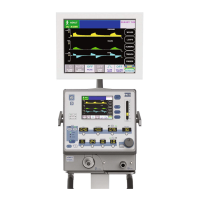Exhalation System
The exhalation system measures the flows and volumes of gas
exhaled from the patient circuit, measures pressure and controls
the exhalation valve to manage pressure in the breathing circuit
and allow patient exhalation.
Figure A-2 e360 Ventilator Exhalation System
Because gas delivered to and exhaled from the patient is
humidified to near 100% relative humidity, the expiratory block
includes a heater to prevent condensate from forming as the
exhaled gas passes through the exhalation system.
The heater heats the expiratory block and flow sensor to prevent
condensation.
The exhalation flow sensor includes a hot wire
sensor and a temperature compensation wire. By measuring the
temperature exchange for the hot wire in the flow sensor the
ventilator calculates the flow of the exhaled gas. The exhalation
flow sensor requires a short calibration before it is put into use.
The calibration is performed by the user at ventilator start-up and
may also be initiated by the user during ventilation if calibration is
suspect.
Gas from the exhalation valve flows to the exhalation flow sensor
.
The exhalation valve includes a flexible silicone exhalation
diaphragm, and drive pressure from the jet pump opens and
closes the diaphragm to manage pressure in the breathing circuit
and allow patient exhalation.
The exhalation solenoid is a small servo valve that controls
pressure to the exhalation valve diaphragm by varying its outlet
size. Gas from the exhalation solenoid enters the jet pump, where
it flows through a jet nozzle to create drive pressure to the
exhalation valve diaphragm.
The low mass of the jet pump allows
it to operate without the complications caused by oscillation of a
larger part.
A-10 SER360 A1106

